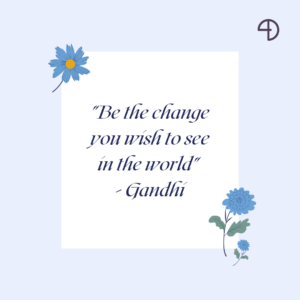
What can I do to help?
I am sure many of you feel as distressed and wretched as I do at the news coming out of Ukraine. Just when we felt we were emerging from the pandemic, the devastation of a war in Europe crashes in.
I have reflected a lot over the past few days on the reaction around the world towards recent events. As with any devastating challenge or trauma coming into our lives, be it a personal, professional, or global curveball, many of us will be spiralling through a powerful, and complex mix of anger and outrage, helplessness and hopelessness, sadness, and despair, as well as love, hope, compassion, and kindness.
And as many of us watch the often-overwhelming footage of destruction and hear the heart-wrenching stories of pain and loss, we may be asking – What can we do? How can we help? We can donate of course but perhaps this doesn’t always feel enough. While we can admire and appreciate those who hurry to the borders to help refugees, that is simply not an option for so many people. So, what can we do?
Aside from doing anything we can to help individuals, support those in need and stand up for freedom and peace…we can also come back to ourselves and start there. Whether in conflict with one other person or a group or a state – we can rage and blame of course…and we can also choose to come back to ourselves and ask: How do we want to ‘be’ in this? Who and how do we want to be in response to aggression and conflict? Here are three reflections which we hope offer some support…
Behind the Boundary
Strong, supposedly negative, emotions like anger, rage or sadness can get a bad rap. These ‘negative’ emotions can be discouraged or rejected throughout our childhood and into our adult lives. And, yes, getting stuck in an emotion like anger is dangerous for us, our relationships, our society, and our health. However, whether you think about a personal conflict in your life or current events, we can understand the response of strong emotions in a different way. Whether we respond with rage, anger, sadness, or despair – strong and often difficult emotions can carry important messages for us. Anger, for example, can often arise as a ‘no’ to someone crossing our boundaries or ignoring our values. And when we understand anger as ‘no, this is not okay’ then we can start to take agency and make choice in a situation. Fear on the other hand may be calling us to act towards our safety and the safety of loved ones. Rather than getting stuck whirling around in a storm of difficult emotions for days, months or years, we need to understand these feelings as messengers that something isn’t okay, something has to change – emotions as a call to action. Signals sent by our body to help move us to a better place. As therapist Diana Fosha explains, “No matter how scary emotions can sometimes seem, if we allow ourselves to process and metabolise them, they will invariably take us to a good place”. So, if you are in conflict with someone or having strong feelings of anger, sadness, fear, or despair to events, can you listen to the feeling and ask what it is trying to tell you? From there, you can start to act and make choices. You can set boundaries, you can state your position, you can stand up for your values, you can communicate your beliefs and needs, you can feel more solid and sure of your footing and know what for you is okay and not okay.
At 4D we constantly ask the question – “Are you happening to the world, or is the world simply happening to you?” We ask this in terms of leadership, communication, and the impact we make. And this question is as, if not more, relevant when the hardest of times are upon us. When we lose someone we love, when our security feels threatened, when we are hurt, when we are scared and when we see war unfolding around us. It is at times like this that the world can happen to us, that we can feel so emotionally overwhelmed that we are lost in feelings of rage, anger, hurt or helplessness. It is by coming back to our 4th dimension – our intentional dimension- that we can start to get back to choice. It is from our intentional selves that we can happen to the world again.
Be the Change
You have no doubt heard the often quoted and yet highly relevant quote from Ghandi “Be the change you wish to see in the world.”
As we face conflict or injustice in our lives, it can be tempting to let our anger, grief or hopelessness dictate our actions. But, if we want to live in a world where kindness, care, love, understanding, compassion, and humanity far outweigh cruelty and conflict or despair and defeat, then where in our own lives can we reduce conflict, increase understanding, reach out with love, or show an act of kindness? How are we living the values we so desperately want to see on the global stage?
By firing up our 4th dimension – our intentional dimension – we can surface from drowning in overwhelming and sometimes paralysing emotions – and get back to choice. From here, we can choose to put into the world and into our relationships more of the qualities we ourselves want to see in the world. So, what one word can you put in your head today that will set your intention for the day? That helps take you from feeling paralysed to purposeful, that redirects your anger to action, that helps you climb out of a spiral of hopelessness back up to a place of choice and hope. You may choose a word like loving or kind or motivating or caring or even playful or fun…by setting an intention through simply putting that one word in your head today, you will change your state, change your impact, change other people’s day, and create a ripple effect that can truly effect change in the world.
By coming back to ourselves and coming back to choice – we come back to possibility. And by coming back to ourselves and then coming together, we are working from the kind of consciousness, collaboration, leadership, and love that really gives us all a chance to build the day, the relationship, the business, the community, and the world we truly want to build.
Let go of the Past
Finally, conflicts can often arise from the seeds of ancient historical disagreements and bitterness. While we might question global actions based on decades or centuries old grievances, we might also look to ourselves and question how this very practice shows up for us. How many of us hold onto old narratives of wrongs done to us in the past that justify our feelings, actions, and choices today? How many of us live moments of aggression or anger, sadness or stubbornness that have their roots in arguments or hurts from months or years ago? Even without knowing it, many of us can still be holding onto old hurts that continue to hurt us every day. We carry those past pains into the present day and live and breathe them as part of our story. What would it be like to let go of those stories? To release ourselves from the past hurts, to choose today to put down that emotional baggage and let it know we don’t need it anymore. That we are choosing to walk forwards without it now. While the pain we feel from past wrongs done to us may be totally justified, when we carry them with us every day, they become a burden that often end up hurting only us in the here-and-now.
I hope these three tools are as helpful to you as they have been for me.
I send you much love and to all of you caught in conflict – you are in so many hearts and minds and prayers.
Philippa x


